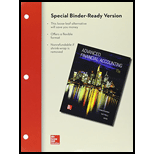
Concept explainers
(a)
Introduction:
Trial balance for adjusted data recording.
(b)
Introduction:
Journal entries to be recorded in R Co.’s books using equity method
(c)
Introduction: Journal entries are a systematic method of recording transactions as and when they occur. It is a summary of transactions divided into the debit and credit items that are recorded chronologically. It is an act of keeping and recording all the transactions occurring in the business.
Eliminating entries needed to prepare consolidated financial statements for 20X7
(d)
Introduction: A consolidated worksheet is used to prepare the consolidated financial statements of the parent company and its subsidiary. It reflects the individual values of the parent and the subsidiary and then one consolidated figure for both the entities.
Three part consolidation worksheet for 20X7
Want to see the full answer?
Check out a sample textbook solution
Chapter 6 Solutions
LOOSE-LEAF Advanced Financial Accounting with Connect
- Please explain the correct approach for solving this financial accounting question.arrow_forwardWhat price should sam pay for the bike if he think he can resell it for 9800 ? Solve ths general accounting questionarrow_forwardI need help solving this general accounting question with the proper methodology.arrow_forward
- Can you help me solve this general accounting question using the correct accounting procedures?arrow_forwardCan you explain the correct methodology to solve this general accounting problem?arrow_forwardI need help with this general accounting question using the proper accounting approach.arrow_forward
- Please explain the correct approach for solving this general accounting question.arrow_forwardKindly help me with this General accounting questions not use chart gpt please fast given solutionarrow_forwardI am trying to find the accurate solution to this general accounting problem with the correct explanation.arrow_forward
- I need help solving this general accounting question with the proper methodology.arrow_forwardPlease help me solve this general accounting problem with the correct financial process.arrow_forwardI need the correct answer to this general accounting problem using the standard accounting approach.arrow_forward
 Financial AccountingAccountingISBN:9781337272124Author:Carl Warren, James M. Reeve, Jonathan DuchacPublisher:Cengage Learning
Financial AccountingAccountingISBN:9781337272124Author:Carl Warren, James M. Reeve, Jonathan DuchacPublisher:Cengage Learning Intermediate Accounting: Reporting And AnalysisAccountingISBN:9781337788281Author:James M. Wahlen, Jefferson P. Jones, Donald PagachPublisher:Cengage Learning
Intermediate Accounting: Reporting And AnalysisAccountingISBN:9781337788281Author:James M. Wahlen, Jefferson P. Jones, Donald PagachPublisher:Cengage Learning Financial Reporting, Financial Statement Analysis...FinanceISBN:9781285190907Author:James M. Wahlen, Stephen P. Baginski, Mark BradshawPublisher:Cengage Learning
Financial Reporting, Financial Statement Analysis...FinanceISBN:9781285190907Author:James M. Wahlen, Stephen P. Baginski, Mark BradshawPublisher:Cengage Learning



